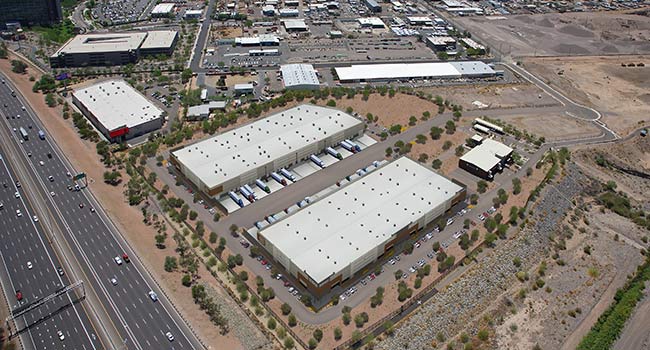The Greater Phoenix industrial real estate market posted a strong fourth quarter finish to 2017, which was one of the city’s historically best years. Net absorption was the strongest in a decade, absorbing robust construction completions and pushing the vacancy rate to a 10-year low. To view the full industrial report from Colliers International in Greater Phoenix, click Here.
Net absorption of industrial space topped 2.1 million square feet in the fourth quarter, bringing the 2017 total to approximately 9.2 million square feet. Large tenants drove up absorption during the past year, including Conair with its 800,000-square-foot space and UPS taking occupancy of more than 600,000 square feet in the Northwest Valley. The Southwest Valley posted more than 1 million square feet of net absorption in the last three months of the year.
Industrial vacancy declined during each quarter of 2017, ending the year at just eight percent. The vacancy dropped 30 basis points during fourth quarter and is 140 basis points below year-end 2016. This marks the lowest industrial vacancy rate in Phoenix in more than 10 years. The Airport Area saw the most significant decline as the submarket’s recently completed spec projects experienced leasing.
Approximately 1.2 million square feet of new space was completed during the fourth quarter, bringing the total addition to the industrial inventory for 2017 to 5.6 million square feet. Construction has been steady in recent years, averaging 5.5 million square feet per year since 2013. The market is expected to have 6.5 million square feet of new construction in 2018, the majority of which will be located in the West Valley. The new Loop 303 freeway will be the focus of more than three million square feet of new building.
Asking rental rates dropped down a bit in fourth quarter 2017, but the year-end average of $0.57 per square foot is a 2.2 percent increase from year-end 2016. Rental rates rose more steeply during 2015 and 2016. The market experienced a leveling-off of big-box distribution rental rates during this past year, which impacted the overall rental rate trend. Rental rates are expected to increase approximately three percent during 2018. New projects are being priced at the higher end of the rent spectrum and, if leased quickly, could push rates up in existing properties.
Sales of industrial buildings rose 13 percent during the final three months of 2017. Sales velocity for 2017 was 16 percent higher than 2016 levels. More buildings were sold in 2017 than in any year since 2007. The median price for 2017 sales was $83 per square foot, up nearly 15 percent from 2016. Cap rates compressed during 2017, particularly in the second half of the year. The average cap rate during fourth quarter was in the mid-six percent range. The average cap rate for 2017 was approximately seven percent, down 30 basis points from the 2016 average.
Greater Phoenix enjoyed great momentum in its industrial market during 2017. Tenants took large blocks of space, development kept a healthy pace and vacancies tightened. This momentum should continue in 2018 as businesses continue expansion. Development of new projects is expected to increase since the city is now experiencing a 10-year low in vacancy. The vacancy rate may show a few quarterly upticks during 2018 as new projects come online and need time for lease-up. Strong tenant demand should compensate for that and produce an overall rate decline by year-end 2018. Investment activity is expected to be healthy since property performance is strong and market sentiment is optimistic. Interest rates are expected to rise, but increases thus far have not slowed the pace of investment activity in this market.
2017-Q4-IndustrialSnapshot-Greater Phoenix-Colliers




